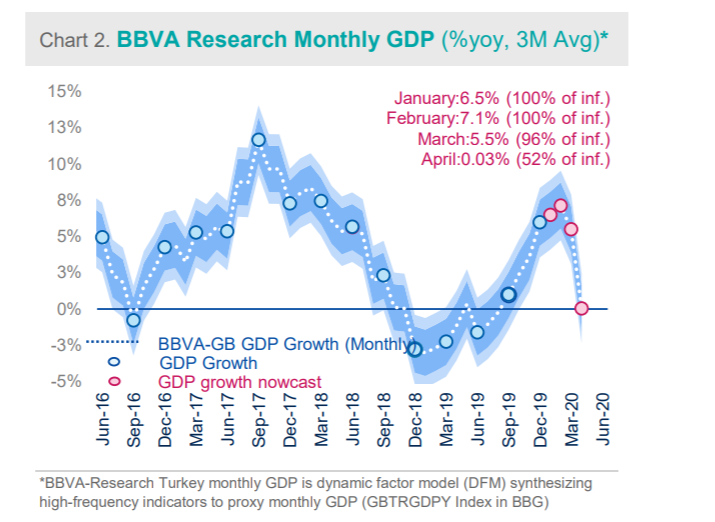BBVA Turkey, formerly Garanti Bank Research Team is one of the few institutions in Turkey which does nowcasting based on big data analysis. Its recent report incorporates sectoral data, such as electricity consumption, as well as Turkstat stats on retail sales to draw the most up-to-date picture of the Turkish economy. A sharp contraction in progress. Yet, certain leading indicators are bottoming out. The outbreak permitting, the report suggests, Turkish economic activity could surge in 2H2020.
Here are excerpts from the report
What do March-April data tell us?
Industrial Production (IP) in March contracted by 2% yoy in cal. adj terms as the restrictions to fight the COVID started to hit the economy. Retail sales also surprised on the downside by contracting 0.2% in yearly terms. In monthly terms, the contraction was even sharper with 7.1% in IP and 8.1% in retail sales. Accordingly, our Big Data indices for both Consumption and Investment have showed a sizeable adjustment till mid-April, but they are currently consolidating the bottoming-out process with some recent acceleration as some of the restrictions have started to be lifted. Therefore, our monthly GDP indicator (GBTRGDPY Index in Bloomberg) has adjusted rapidly to near 0% as of April (52% of info) from a growth rate of 5.5% yoy for 1Q20 (96% of info). The adjustment will deepen further since our indicator is a three month moving average and the incoming information from 2Q will be more negative. We still expect a yearly GDP contraction of around 5% in 2Q (though, as TURKSTAT announced, data restrictions as a result of the delays in VAT declarations till the end of July could increase volatility in the very short term).
Given the assumption of a partial gradual recovery in the second half of the year, we maintain our 2020 GDP growth forecast at 0%.
A Sharp deterioration led by capital goods and export-oriented sectors
The IP (sa & cal adj) experienced a historically high monthly decline of 7.1% in March led by the widespread falls in main subsectors but especially sharper contractions in capital and non-durable consumption goods productions (-2.4pp and -1.8pp contributions, respectively). In sectorial detail, the deterioration was broad-based but the production in export-oriented sectors such as automotive, clothing and textile suffered the most (-1.5pp, -1.1pp and -1.0pp contributions, respectively). Therefore, the 3-month average year-on-year IP growth rate (cal adj.) decelerated sharply to 4.4% in March from 8.5% in February. Taking into account the negative impact of the outbreak gaining momentum after mid-March, the deterioration proved to be sharper than expected with today’s data, while our big data indicators (Charts 4-5) start to show some stabilization signals since the second half of April but still remain at subdued levels (including negative calendar impact due to extended weekend curfews) which would weigh down further on April IP (Chart 3). Other high frequency indicators as electricity production (-16% yoy), manufacturing PMI (33.4) and auto production (-91% yoy) also confirm this expectation for April.
On the other hand, more recently, our Big Data proxy for Consumption maintains a sluggish recovery with 13% yearly contraction in the second week of May with goods sales growth already moving in positive territory. Our Big Data proxy for investment is still in negative, where construction weighs down on the overall figure, while machinery investment seems to be boosted by favorable base effects.
We expect GDP growth to realize 0% in 2020 after contracting around 5% in 2Q
Our Big Data indicators have already started to show some stabilization signals, which would be our main assumption to observe a partial gradual recovery with the normalization steps. So, assuming such a recovery in the second half of the year, we expect 2020 GDP growth to be 0%. The persistence of the shock and the success of the current both global and local measures will all be the determinants of the shape of the recovery thereafter.
BBVA Turkey Research Department
You can follow our English language YouTube videos @ REAL TURKEY: https://www.youtube.com/channel/UCKpFJB4GFiNkhmpVZQ_d9Rg
And content at Twitter: @AtillaEng
Facebook: Real Turkey Channel: https://www.facebook.com/realturkeychannel/
